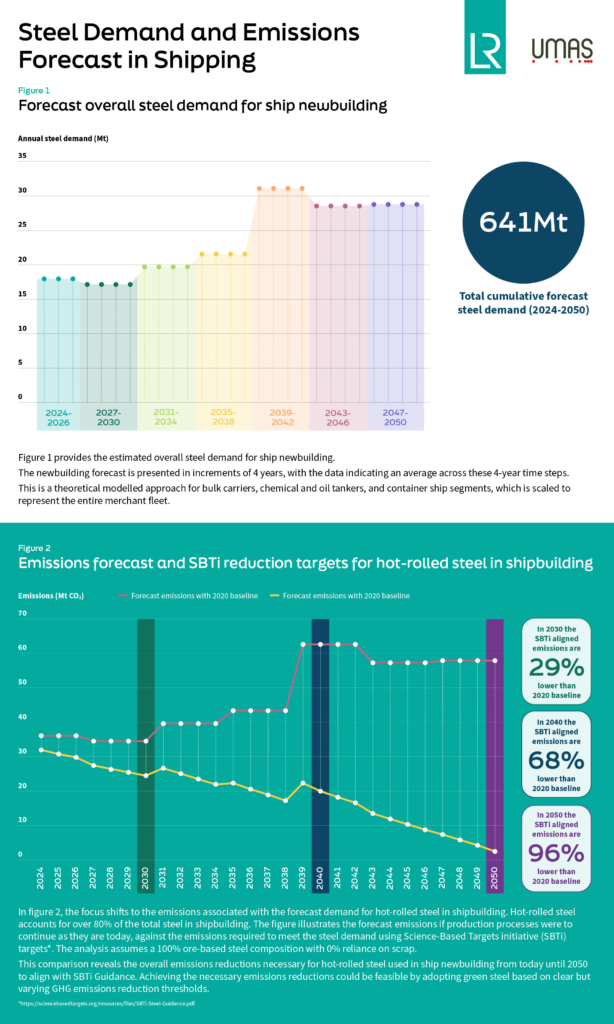Factcheck: 21 misleading myths about electric vehicles
In October 2023, Carbon Brief fact-checked 21 of the most common – and persistent – myths about EVs.
The 2023 Breakthrough Agenda, the annual collaboration between the International Energy Agency (IEA), the International Renewable Energy Agency (IRENA) and the UN Climate Change High-Level Champions, found that both total CO₂ emissions and direct CO₂ emission intensity from the steel sector need to fall by around 25 percent by 2030 to be on track for net zero by mid-century. This corresponds to a 3 percent decrease per year this decade. While the steel sector is not yet on track to meet international climate goals, collaboration in key areas, such as standards and regulation, financial and technical assistance, and market creation, can turbocharge the transition.
Shipping has a dual role to play in this transition – as a buyer of green steel for shipbuilding, containers and infrastructure, and as a supplier of steel scrap from ship recycling. Additionally, the shipping sector transports a big proportion of steel produced globally, impacting the steel industry’s scope 3 emissions. This further highlights the interconnectedness of the two sectors and the need for collaboration in strengthening their decarbonisation efforts.
Currently, “green steel” is used as a catch-all term for steel with lower embodied emissions with various definitions suggested by different institutions. Going forward, it is preferred that the steel sector agrees on a definition based on clear GHG emissions reduction thresholds that also considers environmental, social, and socio-economic sustainability aspects.
An analysis from Lloyd’s Register Maritime Decarbonisation Hub and UMAS found that international shipping could save 776MtCO₂ cumulative emissions between 2024 and 2050 by progressively adopting hot rolled steel with lower embodied carbon (i.e. produced through lower emission processes and material inputs). Hot rolled steel is highlighted in this analysis as the Science Based Targets initiative (SBTi) steel sector guidance currently covers steel in this condition, and hot rolled steel represents the majority (over 80 percent) of steel tonnage used for shipbuilding.
The analysis uses a forecast of the number and steel mass of newbuild ships likely to be built between 2024-2050, in line with expectations of growing demand, as well as achieving IMO GHG reduction ambitions.This is then used to estimate the potential CO₂ emissions savings that could be achieved if the majority of the hot rolled steel used had lower embodied emissions, in line with the trajectory set by the SBTi steel sector guidance.

Continuing with business as usual, where the aforementioned volume of hot rolled steel is produced based on current production methods, will result in the shipping sector indirectly contributing to the creation of 1.3GtCO₂ in the period to 2050.
In order to align with the SBTi steel sector guidance, the international shipping sector could demand that its newbuild ships are built using green steel based on clear GHG emissions reduction thresholds that also considers environmental, social, and socio-economic sustainability aspects.
Increasing green steel production requires action from both the steel sector and from its demand sectors, including shipping. Incentivising the use of green steel in shipping is critical to driving up demand, which in turn will incentivise increased production of green steel from steel producers. Furthermore, there is an expectation that interest in green steel will increase in the sector as shipowners begin to understand and explore ways to reduce their Scope 3 GHG emissions.
The 2023 Breakthrough Agenda recommends that demand sectors move beyond commitments and pledges to contracts and policies, alongside sharing procurement data, in order to strengthen demand signals to the steel sector. Collaboration is built on knowledge sharing and transparency, and it ensures that decision-making is based on accurate and equal information. The time for action is now – increasing collaboration between the shipping and steel sector will improve the understanding of the practical ways that green steel can become a reality for both industries.
In October 2023, Carbon Brief fact-checked 21 of the most common – and persistent – myths about EVs.
A new report launched today at COP28 examines shipping’s short and long-term impact on ocean health, productivity, and biodiversity, highlighting the importance of a coordinated approach and links between actions to decarbonize and protect ocean health anchored in shipping practices.
Andrew Dumbrille & Elissama Menezes from maritime solutions organization, Equal Routes discuss the 2030 Shipping Pact for People and Nature (2030 SPPaN) which envisions a future where sustainable shipping practices benefit nature, people, and the planet, overcoming hurdles through partnerships, accountability measures, and a holistic approach to governance.
Shipping sector leaders have commited to scaling up zero-emissions fuel derived from renewables-based hydrogen to nearly 11 million tonnes by 2030, sending a clear signal to the nascent industry.